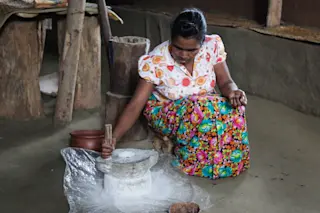A Sri Lankan woman grinds flour by hand, similar to how prehistoric women may have. (Credit: Adam P/Shutterstock) Compared to hunting and gathering, farming can seem like pretty easy work. But the skeletons of Central European women who lived during agriculture’s earliest days would like to tell you otherwise. An analysis of prehistoric women’s upper arm bones shows they took on formidable tasks of manual labor, likely during the course of tilling, harvesting and otherwise managing farm fields. And the hard work left them pretty beasty — it was enough to make them stronger even than modern female competitive athletes today, researchers say.
Cambridge archaeologist Alison Macintosh led a team of scientists who published a study Wednesday in Science Advances comparing the bone structure of modern female athletes to female farmers in the Neolithic period and Bronze and Iron Ages. Not only is this the first study to compare the ...














